
Dawn over Scituate Harbor from Chip Ahoy.
June 24, 2012
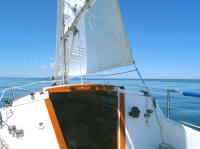
By late morning the wind had died,
the ocean's surface turned to glass.
June 24, 2012
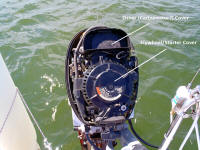
Back home on the mooring:
The Honda 8 Four-Stroke
with its cover removed.
|
Sunday, June 24, 2012; 9:00 pm
Home in Marblehead
This morning I dropped the mooring at 8:15 am, stopped by the Miller
Wharf Marina fuel dock and topped off the gas tank. It took 2.45 gallons
($12 worth), then I was on my way home.
Past Scituate Light and outside the breakwater, once clear of the worst
of the lobster trap buoys, I hoisted sails on my way toward the
sea buoy, shut down and raised the outboard. The sun was still low on
the horizon but not directly in my eyes heading out – as it’s often been
on similar departures – thanks to the early sunrise. The breeze was
nice, as forecast: though more out of the NNW than NW; light, maybe 7-8
mph. The blue sky was literally devoid of clouds, and the sea was
running 1-2 feet. I had to sail a bit further toward the north than my
route called for, to point as close as possible to the wind but that was
fine as I was dodging lobster trap buoys non-stop anyway.
At
9:30 I called Barbara and told her I was on my way home, told her of the
fine conditions and predicted an ETA at Chip Ahoy’s mooring of about
3:30-4:00 pm, according to the GPS.
At about 10:30, as I passed the Minot Light waypoint about 5 miles
offshore, the wind began to slacken and shift a bit more from the west.
The sea had almost flattened. Chip Ahoy was bobbing near motionless so I
decided to lower and start up the outboard until there was some wind.
When I pushed the electric start button the outboard responded with a
sharp clunk and jolt – then nothing. I pushed the button again and got
only a click. Uh oh, I’ve been here before. So I tried
pull-starting the outboard – but the cord wouldn’t budge the flywheel.
Oh yeah, I was here before a few years back, and this isn’t good.
The
last time this happened, a year after I bought this Honda 8hp 4-stroke
new, Ryan’s Marine Service – the local Honda dealership – had to come
out to Chip Ahoy on its mooring and repair it. I wasn’t there when they
fixed the problem, but was later told that the electric starter’s bendix
gear had jammed into the flywheel. As I recall, they’d had to remove the
outboard and bring it to the dock, where they’d pried the gears free and
replaced the starter.
Chip Ahoy and I were now located five miles offshore in the Boston
Harbor shipping channel more than twenty miles from my mooring. The
worst news was that there was no wind and the boat was adrift with no
motor. The best news was there was nothing in sight but Minot Light
miles aft and to port, a distant hint of the Boston skyline way off
ahead and to port, a bare hint of the Salem power plant smokestacks way
off on the horizon ahead, and nothing else in any direction; the sea was
absolutely flat, the sky was clear, and the temperature was a
comfortable mid-70s; there was no threatening weather in the forecast
until the next day – and not a lobster pot buoy in sight. For a bad
situation, conditions couldn’t have been better.
I
raised the motor, removed its cover, and discovered there was another
cover over the flywheel/starter blocking my view and access. The heads
of the three bolts holding it on were recessed, uh oh – what do I have
for tools aboard?
Usually I've had a pretty complete toolkit aboard, especially on my
longer cruises – a set of ratchet wrenches and sockets, various wrenches
and pliers. I was talked out of this need by some of the C22 racers when
I was trying to reduce weight from the boat, raise its waterline. Now I
keep only a basic set of tools aboard, bring along a bag with all the
extras when I go on an extended cruise then take the bag home when it’s
done. I knew what I’d find would be limited, and it was. I recalled the
old saying, “Better to have and not need than need and not have”
with irony. This was precisely why I used to carry along all those
tools, and their additional weight.
I
tried calling Mark, owner of Ryan's Marine Services, to find out if it
was worth trying to take off this cover, risk losing something overboard
in the process. Was there anything I can do even if I get the cover off?
Was replacing the starter a critical solution the last time? I left a
message on his answering machine when it informed me they were closed
for the weekend.
I
called Barbara and told her the situation, asked her to call around and
try to find another number for Mark, his home or cell phone number.
After a lot of effort she called back half an hour later with no results
– so I decided to proceed if I could.
By
then I’d taken a complete tool inventory and it wasn’t impressive or
encouraging. I had an antique set of sockets and strange extensions her
father had left to Barbara, but none of the sockets would fit. The
Japanese outboard was likely metric, found two metric deep sockets – but
one (9mm) was too small and the other (11mm) was just barely too large.
I have no recollection why they’re even aboard. The bolt head must be
10mm, I concluded.
I
found the Honda toolkit in its factory-wrapped plastic pouch, found an
open-end wrench, 8mm/10mm,, among a few other emergency items (spare
pull rope, spark plug ‘wrench’, safety clip, etc.) – but one of the bolt
heads was too recessed to get the open-end wrench on. So I decided to
perform further surgery, amputation of the large component blocking the
one bolt that was otherwise unreachable. It was held in place by rubber
posts that I could pop it off from, but connected by various hoses and
electrical wiring and plugs I couldn't see well or get at.
To
reach all this I needed to tilt the motor, but the grip ordinarily used
for tilting is on the cover, and the cover was now off, sitting in the
cockpit. I removed the stern lifeline and moved it out of the way, then
had to lean way out over the outboard, find a handhold beneath the back
of it. From that position tilting the heavy motor seemed impossible –
but in desperation I gave it everything I had and felt it tilt a bit
then got it done, also feeling something give in my lower back. Great.
Once I got the aft assembly pulled out of its pegs and enough out of the
way I was able to get the open-end wrench onto the back bolt and loosen
it enough to very, very slowly turn it with my fingers – very
carefully so I didn’t drop it into the deep blue below. I kept reminding
myself that my highest priority every second was to “first do no harm”
by losing a part, any part. There are no replacements out here.
I
patiently removed the three bolts, carefully placed them one by one in
the cockpit, then removed the cover. Sure enough, the flywheel and
bendix gear were jammed hard. Okay, I’d now at least identified the
problem – just as I recalled it described to me from the last time; just
as I’d expected to find.
I
tried lightly tapping the starter shaft in the center of the bendix gear
with a small tack hammer from the limited toolbox – “first do no
harm” – but accomplished nothing. I tapped as hard as I dared with
no result, so I used a screw driver to pry between the two gears while
tapping and SNAP, they suddenly separated. By God, I think
I’ve fixed the problem!
I
slowly put everything cautiously back together in reverse order,
tightened everything up. I pushed the starter button and the motor
kicked right over. Success!
I
had to tilt the motor back out to get the cover on (oh my aching back),
but couldn’t get the rubber seal between the motor housing and cover on
straight, even after a few attempts. I’d have to hang too far out over
the outboard to get it right, and decided it could wait until I got back
to Chip Ahoy’s mooring: Better to fall overboard trying in the harbor
surrounded by other boats than out here in the middle of Massachusetts
Bay alone and with nothing and nobody in sight.
With the motor lowered and the cover locked on (if not tightly sealed),
I pushed the starter button again, the motor kicked right over and
caught, and the job was done. The motor would not be shut off until I
reached my mooring, I decided.
After putting away all the tools and reorganizing the cabin and boat I
took another look around and, as in all my many other looks, there was
still nothing in sight. No breeze had raised during the hour-and-a-half
surgery, the sails hadn’t moved Chip Ahoy far if at all. Minot Light
looked to be where it was when this ordeal began more than an hour
before, and the GPS track didn’t appear to have budged.
I
called Barbara, told her I’d fixed the motor, that it was running again
and I was about to continue on to Marblehead. She replied that she’d had
confidence that somehow I’d get it running again. My buddy Ace, who
she’d called trying to run down Mark’s phone number, had told her that
sooner or later the wind would return anyway.
The
rest of the trip back was uneventful. I finally found some breeze around
the Boston Harbor buoy waypoint, still light and NW. By the time I left
Massachusetts Bay and entered Salem Sound at Marblehead Rock the breeze
had picked up a bit, but I kept the outboard running. I reached Chip
Ahoy’s mooring at about 5:30 pm with my aches and pains. Besides
throwing out my lower back, apparently I’d pulled something in my right
forearm from wrestling to get that motor tilted; it was scraped,
scratched, bruised and very sore. I wrapped it with an Ace bandage then
continued stowing things below, covered the main sail, and closed up the
boat. I decided to deal with the rubber seal on the outboard’s cover
some other time when I could move a little better. I called for and took
the launch to the dock and was home around 7 pm.
All in all, this was a shakedown cruise that needed to
happen — and hopefully it strengthened a
couple weaknesses. |
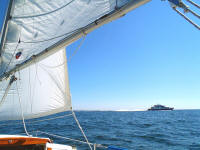
Conditions were perfect for the sail
home.
The Provincetown Ferry blasts across
from Boston ahead of Chip Ahoy.
June 24, 2012
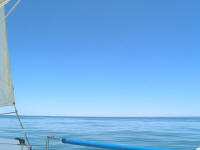
There was one other lone sailboat
in sight, on the horizon,
when I tried starting the outboard.
It jammed and needed serious repair.
June 24, 2012
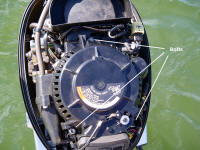
Back home on the mooring:
The three bolts which needed to
come out for the flywheel/starter
cover to be removed.
|